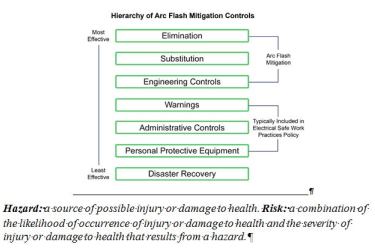
The Importance of Arc Flash Mitigation
De-energizing equipment does not absolve the facility from the responsibility of performing an arc flash analysis or providing the necessary PPE.
- By Antony C. Parsons
- Jun 01, 2017
While the threat of shock and electrocution from inadvertent contact with energized parts has long been recognized, the arc flash and arc blast hazards have only fairly recently been incorporated into the electrical safety standards. The Occupational Safety and Health Administration (OSHA) enforces electrical workplace safety standards outlined in the National Fire Protection Association's NFPA 70E: Standard for Electrical Safety in the Workplace®.
Basic compliance with NFPA 70E-2015 Edition guidelines can be established with a five-step process:
Step 1: Develop and audit an Electrical Safe Work Practices (ESWP) policy.
Step 2: Conduct an electrical system study to determine the present degree of arc flash hazards and label the equipment.
Step 3: Ensure adequate supplies of personal protective equipment (PPE).
Step 4: Conduct regular safety training and employee assessments.
Step 5: Maintain all electrical distribution system components.
Companies can take additional steps to reduce the potential for an arc flash. The remainder of this article will focus on mitigating arc flash hazards, specifically engineering controls.
What is Arc Flash Mitigation?
According to Webster's dictionary, mitigation is defined as "to make milder, less severe or less violent." When applied to electrical workplace safety, arc flash mitigation involves taking steps to minimize the level of hazard and/or the risk associated with an arc flash event.
ANSI Z10-2012, Occupational Health and Safety Management Systems, included a hierarchy of arc flash mitigation controls, as shown below:

PPE is often mistakenly viewed as the "solution" to arc flash hazards. The reality is that even when PPE is properly selected, it does not guarantee freedom from injury. NFPA 70E only makes the claim that injuries sustained during an arc flash event would be "reduced" and "survivable" due to mitigating effects of arc-rated PPE.
An effective safety program does not settle for "survivable" injuries; instead, the most effective arc flash safety programs look to incorporate "safety by design," primarily through application of engineering controls. Though not as effective as substitution or elimination, the goal of engineering controls is to reduce the degree of hazard. Administrative controls and warnings are less effective because they rely on workers following proper procedures and safe work practices.
The engineering controls covered in this article will either:
1) Reduce arc flash energy to a level where permitted tasks can be performed, or
2) Locate the worker so that he/she is not subject to harm.
Arc flash reduction systems do not eliminate the electric shock hazard of working on or inside energized equipment. The amount of arc flash energy reduction will be determined by an engineering analysis. The goal of reducing arc flash energy levels is to reduce the severity of the potential arc flash hazards to which a worker may be exposed. PPE is still required when an arc flash energy reduction system is employed, but the level of PPE may be reduced.
While arc flash mitigation has always been a good idea, there have not been specific requirements for it in industry codes and standards until recently. However, NEC 240.87 was significantly revised in 2014 and now requires Arc Energy Reduction means to be applied on LV circuit breakers 1200A or larger. In the next section of this article, we will explore options for mitigating arc flash hazards that may be used to meet this requirement or for other mitigation purposes.
Reducing Arc Flash Energy Levels
Here we'll discuss various ways to reduce arc flash energy levels, including circuit breakers, over-current protective device coordination studies, specialized relaying, and other arc flash mitigation systems.
The Role of the Circuit Breaker or Fuse in Lowering Arc Flash Energy Levels
Why is a circuit breaker or fuse always considered in the arc flash analysis? Because arcing time is the key determining factor for arc flash energy. Per the equations in IEEE Std. 1584-2002, arc flash incident energy varies linearly with time. If the duration of the arcing fault doubles, the available energy doubles; halve the duration and you cut the energy in half.
Because incident energy is proportional to arcing time, the use of faster-acting devices is key. As a result, proper selection of overcurrent protective devices—in particular, selecting devices that will quickly clear arcing faults from the power system—is a powerful mitigation strategy.
Over-Current Protective Device (OCPD) Coordination Study
An OCPD coordination study optimizes the protective device setting for reliability and arc flash protection. While an OCPD study is not a requirement of an arc flash analysis, it is recommended to have this study completed as a component of an arc flash analysis. The OCPD coordination study will determine whether minor adjustments in circuit breaker (or other over-current protective device) settings can lower incident energy levels. However, settings must be chosen to properly protect equipment while still allowing for normal load currents and routine temporary overcurrents (e.g., motor starting current) to flow without causing a trip.
Specialized Relaying, Such as Optical Technology
Quickly clearing faults is a key to arc flash mitigation. Circuit breaker or relay settings near the source of power may have significant time delays to allow for coordination of downstream devices. A relatively new way to address this issue is to use relays that detect the presence of arcing faults by looking for the flash of light associated with the arcing fault in addition to the characteristic current flow.
However, for an arcing fault to be detected, both the high current and a burst of light must exist. When both conditions are present, the optical relay can operate very quickly and send a signal to an upstream breaker or interrupter to clear the fault. Optical relays also can be used as the protective relay in a virtual main configuration.
Virtual Main Arc Flash Mitigation Systems
Switchgear and switchboards can be subjected to dangerous levels of arc flash incident energy when fed directly from a power transformer. The addition of a virtual main system, where a digital relay and overcurrent sensing is added to the low-voltage side of the service transformer, can reduce the arc flash energy on the entire switchgear, including the main incoming section. The system is designed to trip an existing upstream fault breaking device, often a medium-voltage circuit breaker or other vacuum interrupter. Additional features that help further reduce energy or maintain selective coordination may be added, such as:
1) A maintenance selector switch, which temporarily lowers the instantaneous short circuit current setting. The maintenance setting lowers the available arc flash incident energy and temporarily forfeits selective coordination.
2) Zone-selective interlocking with downstream branch circuit breakers in the switchgear eliminates the need for the maintenance selector switch. Arc flash energies can be permanently reduced with zone-selective interlocking.
The remaining section focuses on removing workers from potential harm as a strategy to mitigate risk.
Removing Workers From Harm's Way
De-energizing equipment does not absolve the facility from the responsibility of performing an arc flash analysis or providing the necessary personal protective equipment (PPE).
OSHA and NFPA have rules that prohibit energized work. In order to establish that a circuit is de-energized, the circuit must be approached to verify that it has been de-energized. Until then, the circuit must be considered energized per NFPA 70E and the worker who performs the verification test must wear full PPE. Hiring contractors to perform electrical work does not absolve the facility from performing the calculations and providing the arc flash exposure levels to the contractor’s workers.
The following arc flash mitigation solutions remove a worker from the location of exposed energized parts or place a barrier between the workers and those energized parts.
Infrared Viewing Windows
Having infrared (IR) windows permanently installed into electrical equipment enables IR scans to be performed without removing equipment covers, potentially saving the worker from exposure to hazardous energy. IR windows are made of a glass-like material that is transparent to infrared rays and allows hot spots to be registered by a thermographic camera. They also facilitate permanent access for inspection of electrical components without disturbing operations.
Online Temperature Monitoring
Online temperature monitoring, via wireless sensors, provides continual access to critical connection points where traditional thermography cannot be used. This technology evaluates the equipment’s current condition without exposing workers to energized parts because equipment covers do not have to be removed. The sensors are installed during a planned outage and can be used in equipment with high arc flash ratings without a risk of danger to personnel or equipment.
Remote Racking System
A remote racking system (RRS) allows circuit breaker racking operations to be performed via a control panel located away from the cell, removing the operator from manual contact with the circuit breaker. If the operator controlling the RRS is located outside the arc flash boundary, the need for PPE is eliminated.
Electrical hazards are a significant safety and financial risk for electrical workers and their employers. OSHA mandates that work on electrical equipment must be performed in a manner that does not expose the worker to undue risk of injury. Complying with the safe work practices dictated by NFPA 70E and implementing arc flash mitigation strategies through engineering controls will enhance workplace safety for employees and reduce the financial risk for your company.
This article originally appeared in the June 2017 issue of Occupational Health & Safety.